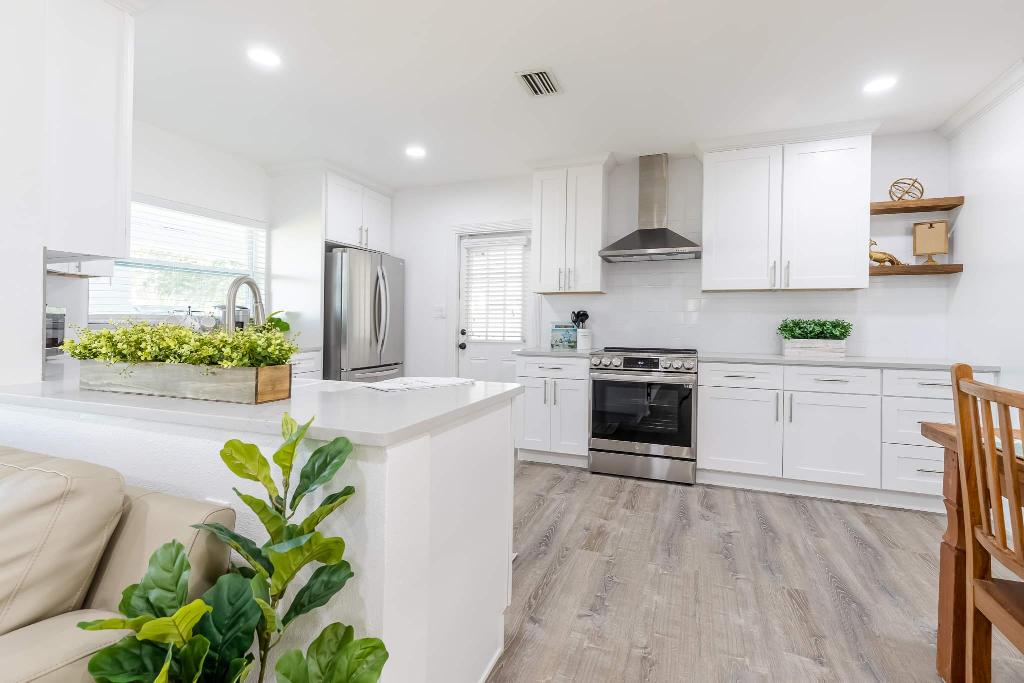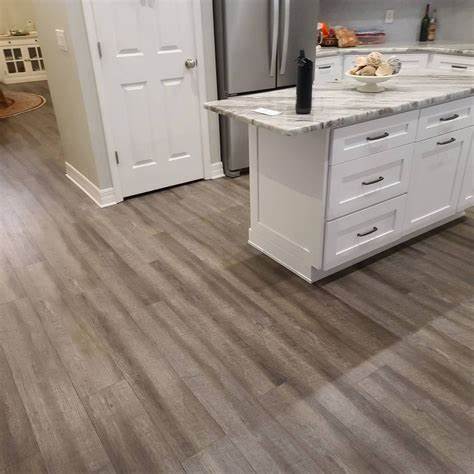Choosing the right flooring is one of the biggest decisions for a home remodel or new build—especially in a climate like Tampa’s. High humidity, occasional flooding, coastal air, and heavy sun exposure all affect how flooring performs over time. In this article, I’ll compare vinyl plank and laminate flooring, weigh their strengths and weaknesses in Florida’s conditions, and help you decide which one is better suited for Tampa homes.
To Request Flooring Services in Tampa FL and Surrounding Cities click here

What Is Vinyl Plank Flooring?
Vinyl plank flooring (often called LVP or luxury vinyl plank) is made primarily of synthetic materials (PVC + additives) and is designed to mimic the look of wood, tile, or stone. It often consists of multiple layers including a backing, core, photographic design layer, and protective top wear layer.
Within vinyl plank, there are variations such as SPC (stone plastic composite) or WPC (wood plastic composite) cores, which improve rigidity, stability, and performance under temperature changes.
What Is Laminate Flooring?
Laminate flooring is constructed with a high-density fiberboard (HDF) or wood fiber core, covered by a photographic design layer and a protective clear wear surface. The core is made from compressed wood fibers, resins, and adhesives.
Because of its wood-based core, laminate is more vulnerable to moisture infiltration (which can cause swelling or delamination) unless it’s specially manufactured as “waterproof laminate.”
Core Differences: Vinyl vs Laminate
- Material & Composition: Vinyl is fully synthetic and inherently more impervious to water in many cases. Laminate contains wood fiber in its core, making it more susceptible to water damage.
- Flexibility & Movement: Vinyl tends to have some give, allowing it to expand or contract slightly without damage. Laminate is more rigid in certain conditions.
- Moisture behavior: Vinyl is often fully waterproof (or very close), while standard laminate is water-resistant but not waterproof. The Spruce+2The Home Depot+2
These core differences start to matter more when you consider Tampa’s climate.
Performance in Florida / Coastal Climates
Tampa’s climate brings:
- High humidity year-round
- Frequent storms, heavy rain, potential flooding
- Salt-laden air near the coast
- Temperature swings and strong sun/UV exposure
In such conditions:
- The moisture resistance of flooring becomes critical. Vinyl’s waterproof properties often give it the edge in resisting warping, buckling, or mold risk.
- Coastal sun and UV exposure can fade surfaces over time; both vinyl and laminate need a good wear layer and UV-safe coating.
- Salt air can corrode metal trims or edges if not sealed properly—so installation quality matters.
- Subfloor preparation (moisture barrier, proper leveling) is essential regardless of which option you choose.
Thus, while both materials will be challenged, vinyl plank often holds up better under prolonged moisture stress.
Durability & Wear Resistance
Scratches & dents: Some higher-end laminates may have better scratch resistance in certain conditions (especially against sharp objects) than budget vinyl. But premium vinyl planks with thick wear layers compete strongly. Rejuvenation Floor & Design+3The Home Depot+3Lowe’s+3
UV & color retention: Quality wear layers on both repel fading; cheap options may discolor.
Edge integrity: Laminate’s edges can chip or delaminate if moisture gets inside. Vinyl is less prone to such edge damage.
Water & Moisture Resistance
This is a critical battleground:
- Vinyl plank is generally waterproof (or very close) and can survive in wet areas like bathrooms, laundry rooms, and basements. House Beautiful+3The Home Depot+3The Spruce+3
- Laminate is water-resistant but not waterproof. Traditional laminate will swell or warp when exposed to water at seams or edges. Lowe’s+3The Home Depot+3House Beautiful+3
- Some newer laminates are marketed as “waterproof” or “flood-rated,” but performance can vary widely. Rejuvenation Floor & Design+1
In Tampa’s climate, where heavy rains, humidity, and occasional flooding are risks, having a truly waterproof floor in vulnerable areas is a strong advantage for vinyl.
Appearance, Texture & Realism
- Laminate has long been celebrated for its realism—texture embossing, deep grain, and varied wood patterns.
- Vinyl plank has improved significantly and many modern LVP products can convincingly mimic real wood or tile.
- Because vinyl is plastic, some lower-end options may look more “synthetic.”
- Laminates often provide more varied style options in mid-tier price ranges. The Spruce+2Carpet One+2
If aesthetics, wood realism, and surface texture are top priorities, a high-quality laminate might deliver a more “wood-like” feel.
Underfoot Feel & Acoustics
Vinyl often feels slightly softer (depending on underlayment or built-in padding).
Laminate is sometimes perceived as firmer or colder underfoot.
For sound, underlayment is key; both types need good underlay with acoustic padding to reduce noise.
In Tampa’s heat, vinyl might transfer less thermal contrast (less cold in winter) whereas laminate over a subfloor could feel cooler.
Installation Options & Ease
- Both floors often use click-and-lock floating systems that are relatively DIY-friendly.
- Vinyl has some additional installation methods (peel-and-stick, loose lay, glue-down).
- Laminate typically needs a more uniformly flat, stable subfloor and stricter moisture barrier prep. House Beautiful+2The Home Depot+2
- Because laminate uses a wood-based core, moisture management beneath is more critical.
- Missteps in installation (bad sealing, poor subfloor prep) can reduce lifespan for either option—but laminate is less forgiving of moisture errors.
Maintenance & Cleaning Needs
- Vinyl: Easier to clean; can handle damp mopping. Avoid harsh chemicals, steam, or abrasive tools.
- Laminate: Must avoid excess water—damp mop only, wipe spills immediately.
- Both types can’t be sanded or refinished if the wear layer is damaged.
- Use cleaning solutions designed for your specific floor type.
Good care will extend the life, but in Tampa homes especially, making sure liquid doesn’t seep into edges is vital.
Lifespan & Warranty Considerations
- Typical warranties range around 10–25 years depending on product quality. The Home Depot+2Carpet One+2
- In well-maintained homes, both types can last 15+ years.
- However, environmental stress (humidity, flooding, UV) may shorten lifespan—again favoring vinyl for wet-prone zones.
- Warranty fine print often excludes damage from moisture or improper subfloor prep—so installation quality matters hugely.
Resale Value & Market Appeal in Tampa Area
- Homebuyers often expect waterproof or moisture-resistant flooring in Florida homes—vinyl can satisfy that expectation better.
- A high-end laminate has aesthetic appeal, but if buyers suspect long-term moisture risk, it might be viewed skeptically.
- For coastal properties, a floor with proven durability against moisture is a selling point.
- If your home is marketed for durability, ease of maintenance, and flood resilience, vinyl may have better appeal.
Cost Comparison (Material + Installation)
- Base materials for both are relatively affordable compared to hardwood or tile.
- Vinyl: you’ll see a range—cheap vinyl up to expensive premium LVP.
- Laminate: mid-tier quality often competes with mid-level vinyl in price.
- Installation of laminate might cost a bit more because of stricter subfloor prep. House Beautiful+2The Home Depot+2
- Always request quotes for both in your region (Tampa) because labor and materials fluctuate.
When Each Option Makes Sense (Room by Room)
- Bathrooms, laundry rooms, kitchens, mudrooms: strong case for vinyl because of moisture exposure.
- Bedrooms, living rooms, hallways: laminate can be great here (if moisture control is good).
- Basements / below-grade areas: vinyl is safer unless the basement is very dry.
- Sunrooms / Florida rooms: vinyl may better withstand sun/heat exposure.
- High-traffic zones & pet areas: go with a durable wear-layer product in either class—but vinyl’s water safety is a bonus.
Common Pitfalls & Mistakes
- Installing laminate in an area prone to water leaks (kitchen, bath)
- Skimping on moisture barrier or subfloor prep
- Choosing a low-budget product with a weak wear layer
- Ignoring edge sealing or trim sealing, allowing moisture infiltration
- Using improper cleaning methods (too much water on laminate, harsh chemicals on vinyl)
- Not checking warranty conditions (some void warranty if moisture damage occurs)
Recommendation for Tampa Homes + Final Verdict
Given Tampa’s humidity, rain patterns, and coastal environment, vinyl plank (especially premium LVP/SPC options) tends to offer better protection against moisture-related problems. Its waterproof nature, flexibility in installation, and resilience under humid conditions make it a safer bet.
However, if you prefer the look and feel of wood, and the rooms are well-sealed and absolutely controlled for moisture, a high-quality laminate can work beautifully in dry zones of the house. Just be vigilant about installation and moisture control.
If I were choosing for a Tampa home, I’d lean vinyl plank for most rooms—especially areas exposed to water risk—and consider laminate only for select dry areas with controlled humidity.
FAQs
Q1: Can laminate ever be used in kitchens or bathrooms in Tampa?
A1: Standard laminate is not ideal in wet areas. Some newer “waterproof laminate” products exist, but their performance can vary. It’s safer to use true waterproof vinyl in kitchens or bathrooms.
Q2: Will vinyl plank feel cold underfoot in Florida’s summer?
A2: No more than laminate. In fact, vinyl often feels slightly more comfortable and less conductive of cold. Underlayments help with warmth and sound.
Q3: Are there hybrid options (vinyl + laminate) that combine advantages?
A3: Yes. Some manufacturers offer engineered composites or hybrid cores such as SPC/WPC that aim to combine rigidity, waterproofing, and look. Evaluate on a per-product basis.
Q4: How important is subfloor moisture barrier in Tampa?
A4: It’s critical. Without a proper moisture barrier, both vinyl and laminate could suffer damage from moisture rising from below. Always install a good moisture barrier and ensure subfloor is properly prepared.
Q5: How should I clean these floors in a humid climate?
A5: For vinyl, you can use damp mopping (not soaking). For laminate, avoid excess water—wipe spills quickly and dry the surface. Use pH-neutral cleaners recommended for your flooring.
Q6: If my floor gets damaged, can I repair vinyl or laminate?
A6: Neither is typically refinished (you can’t sand them). For both, you remove and replace individual planks or boards if they get damaged—provided you have spare stock or matching pieces.
Conclusion
For Tampa homes dealing with heat, humidity, storms, and moisture risk, vinyl plank flooring generally offers a safer, more resilient solution—especially in water-prone areas of the home. Laminate still has merits in dry zones for its visual appeal, but only if installed with care and moisture control in mind.
If you like, I can run a side-by-side cost estimate for your specific house size in Tampa, or even suggest some high-quality product brands that perform well locally. Do you want me to pull those together?

Leave a Reply